.jpg)
The wearable tech market may have grown last year, thanks in no small part to the success of the Apple Watch, but you wouldn"t think that was the case if you"ve been reading anything other than analyst reports. Fitbit"s device sales have been declining, Nokia is dumping its digital health business, and Wear OS (formerly Android Wear) hasn"t appeared on a new piece of hardware in over a year. Wearable makers, right now, are leaning heavily on specialized devices—stuff beyond your basic step-counters—while they try to convince people to wear a Smart Thing on their bodies for longer than a few months.
That"s what Boston-based Whoop has been doing since it first launched: targeting elite athletes and Fortune 500 CEOs (both are part of its marketing) with its sensor-filled, nylon activity tracker and analytics platform. Whoop"s been charging professional and collegiate sports teams anywhere from $1,000 to $2,000 per player for access to the company"s in-depth stats tracking, and the company boasts NFL and NBA teams as clients. Regular people who want to try the band and analyze their performance can do so for a $500 fee. Now, Whoops is turning that model on its head.
Starting today, Whoop is rolling out a subscription service for access to its platform, as well as access to its band. Also, the company is no longer selling the Whoop band as a standalone product, which means the only way to get your hands (or wrists) on this wearable from now on is to pay a $30 monthly subscription fee. Those who bought a Whoop band before this change will be grandfathered in to the analytics service, but newcomers will have to pay monthly dues with a six-month commitment up front.
Whoop"s nylon band tracks a user"s heart rate using an optical monitor with green LEDs, technology common to wrist-worn wearables.
WHOOP
Strong Arm
Whoop founder and CEO Will Ahmed says that offering a "lowered entry point" for potential customers was a significant reason for the subscription service, noting that the $180 upfront cost is the least Whoop has ever charged. "It expands the market," Ahmed said. "What we expect is that after people try it for a period of time, they"re going to see powerful behavior change."
There are also obvious business incentives tied to the new subscription model. Not only does it guarantee a certain amount of recurring revenue, but it "allows them to move expenses from capital expenditure to operating expenditure," says Jitesh Ubrani, an analyst who closely follows the wearable tech market for research firm IDC. "That"s a trend we have seen across device types for businesses."
A subscription-only model for a wearable and its software platform is also a way of pushing people to actually wear the wearable for an extended period of time. Data has shown that a significant number of people ditch activity-trackers within six months, although a lot of the "junk drawer" evidence is anecdotal. But Ahmed insists Whoop has high levels of sustained engagement, with over 50 percent of users remaining daily active users after a whopping 18 months of wearing the band. He says there"s a stickiness associated with Whoop"s analytics platform, which may have a lot to do with the fact that Whoop is catering to elite athletes who already care about their performance, as opposed to nudging people who aren"t already active to be a little more active.
All in the Wrist
Ahmed declined to say whether it"s teams or individual customers who make up the biggest customer base for Whoop"s products, but the company"s own testimonials point to teams being a huge part of the business. So what is it about Whoop that makes it so appealing to the performance athletics crowd–and appealing for investors like the Founder"s Collective, Jack Dorsey, Nicholas Negroponte, the NFL and, most recently, Bose Ventures?
The nylon band might look unremarkable, but Whoop claims it offers a level of granularity other wearable makers don"t–even when that data-tracking becomes potentially invasive, like when a coach can see exactly how much a college athlete is sleeping. The company says it"s collecting five different health-related variables 100 times per second, including heart-rate variability. Other wearable makers, like Apple and Garmin, measure this too; it"s a data point that helps gauge how quickly your body"s nervous system responds to certain activities.
Whoop"s data-related health claims haven"t been peer-reviewed, but the company has published some papers to its website based on its own data, and in general it seems to emphasize the importance of recovery periods for athletes. "I"ve been wearing it for five years and I still wake up not knowing if I"m red, yellow, or green," Ahmed says, referencing Whoop"s color-coded recovery system. "There are mornings where you feel run down but Whoop tells you otherwise, and you manage to crush your workout."
It"s these kinds of semi-addictive features that are part of the draw for teams. The question is whether features like that will draw average consumers to Whoop, for $30 a month. And the question beyond that might be: could other wearable makers adopt this model as well? Some device makers already offer what you might call slivers of subscriptions; you can, for example, subscribe to Fitbit"s Coach app, or a streaming music service with offline playlists, or even the Apple Watch"s LTE service. But those aren"t essential features, and Fitbit"s revenues from Coach are a tiny fraction of its device sales.
IDC"s Ubrani says he thinks more subscription wearables could be rolled out in the future, but for now, it"s the "tiny but lucrative" approach like Whoop"s that is more likely to be the case.
No comments:
Post a Comment